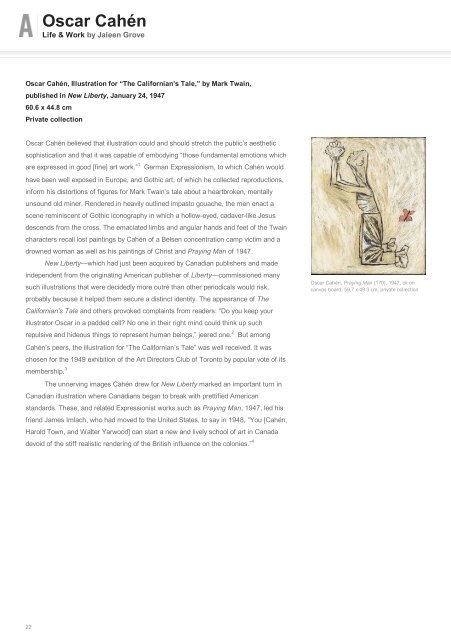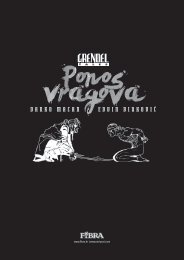Oscar Cahén
Art-Canada-Institute_Oscar-Cah%C3%A9n
Art-Canada-Institute_Oscar-Cah%C3%A9n
Create successful ePaper yourself
Turn your PDF publications into a flip-book with our unique Google optimized e-Paper software.
<strong>Oscar</strong> <strong>Cahén</strong><br />
Life & Work by Jaleen Grove<br />
<strong>Oscar</strong> <strong>Cahén</strong>, Illustration for “The Californian’s Tale,” by Mark Twain,<br />
published in New Liberty, January 24, 1947<br />
60.6 x 44.8 cm<br />
Private collection<br />
<strong>Oscar</strong> <strong>Cahén</strong> believed that illustration could and should stretch the public’s aesthetic<br />
sophistication and that it was capable of embodying “those fundamental emotions which<br />
are expressed in good [fine] art work.” German Expressionism, to which <strong>Cahén</strong> would<br />
have been well exposed in Europe, and Gothic art, of which he collected reproductions,<br />
inform his distortions of figures for Mark Twain’s tale about a heartbroken, mentally<br />
unsound old miner. Rendered in heavily outlined impasto gouache, the men enact a<br />
scene reminiscent of Gothic iconography in which a hollow-eyed, cadaver-like Jesus<br />
descends from the cross. The emaciated limbs and angular hands and feet of the Twain<br />
characters recall lost paintings by <strong>Cahén</strong> of a Belsen concentration camp victim and a<br />
drowned woman as well as his paintings of Christ and Praying Man of 1947.<br />
New Liberty—which had just been acquired by Canadian publishers and made<br />
independent from the originating American publisher of Liberty—commissioned many<br />
such illustrations that were decidedly more outré than other periodicals would risk,<br />
probably because it helped them secure a distinct identity. The appearance of The<br />
Californian’s Tale and others provoked complaints from readers: “Do you keep your<br />
illustrator <strong>Oscar</strong> in a padded cell? No one in their right mind could think up such<br />
repulsive and hideous things to represent human beings,” jeered one. But among<br />
<strong>Cahén</strong>’s peers, the illustration for “The Californian’s Tale” was well received. It was<br />
chosen for the 1949 exhibition of the Art Directors Club of Toronto by popular vote of its<br />
membership.<br />
3<br />
1<br />
The unnerving images <strong>Cahén</strong> drew for New Liberty marked an important turn in<br />
Canadian illustration where Canadians began to break with prettified American<br />
standards. These, and related Expressionist works such as Praying Man, 1947, led his<br />
friend James Imlach, who had moved to the United States, to say in 1948, “You [<strong>Cahén</strong>,<br />
Harold Town, and Walter Yarwood] can start a new and lively school of art in Canada<br />
devoid of the stiff realistic rendering of the British influence on the colonies.”<br />
2<br />
4<br />
<strong>Oscar</strong> <strong>Cahén</strong>, Praying Man (170), 1947, oil on<br />
canvas board, 59.7 x 49.3 cm, private collection<br />
The Adoration 1949<br />
22



